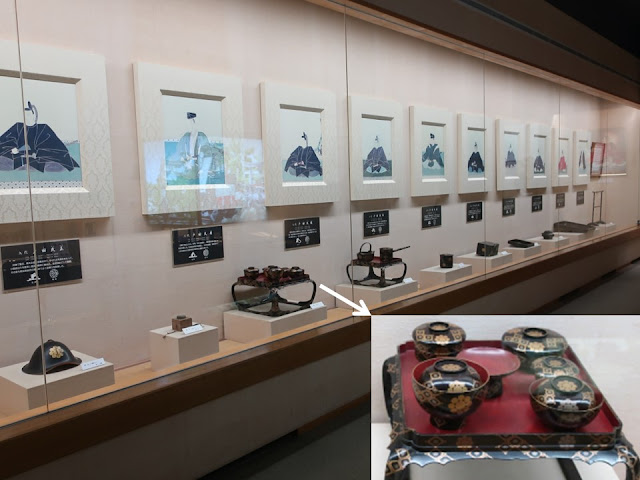The museum is in front of Ogaki Castle; it
used to be in the castle’s site. The classy garden and interior calm down our
minds. The museum exhibits not only war and daimyo
lord but also people’s lives which help us to understand the area. I took photos under the approval of Ogaki City office.
大垣城のすぐ前にあり、庭も内装も上質で落ち着く博物館です。かつては城郭の中でした。城下町の博物館らしく戦いや藩主に関する展示が充実しています。庶民の暮らしに関する展示もあり、大垣の様子がわかります。大垣市の許可を得て撮影しました。
The wooden gate and wall were moved from a chief retainer’s residence of Ogaki han which was a local government in the Edo period (1603~1868).
門と木の塀は大垣藩(10万石)の家老宅から移築したものです。
There is a garden inside the gate and bonsai of satsuki azalea were displayed in behind when I visited.
門を入ると庭園があり、その奥ではさつきの盆栽が展示されていました。
There is a well on the approach of the museum entrance. Around 200 years ago, a flowing well appeared when a konjac (food) manufacturer drove in a bamboo pile; He got pure water. Thereafter, Ogaki people made an artesian well in their ground. The water above is drinkable; Ogaki is call “Water City”.
庭の一角に井戸が作られています。200年ほど前に、こんにゃく屋さんが地面に青竹で打ち込んできれいな水を得て以来、大垣の家では自噴の井戸を掘るようになったそうです。この井戸水は飲用可能です。水都ですね。
The luxurious folding screen depicts “Battle of Sekigahara” which broke out in 1600 and Ogaki castle was used as the headquarters of the Army (lower right). It was the gigantic battle which involved around 160,000 soldiers.
玄関を入るとラウンジにはドドーンと関ヶ原合戦絵図屏風が展示されています。江戸初期に描かれた津軽屏風(大阪歴史博物館蔵)の原寸大の模写で迫力があります。右下が大垣城に拠点を置いた西軍です。
The 1 to 250th scale model of Ogaki Castle is very precise which shows the one in the early 18th century.
18世紀初めの大垣城の1/250模型。広大な城郭ですね。緻密に作られています。
Honoring room to Toda clan、戸田公顕彰室
The daimyo lord of Ogaki was Toda clan from 1635 to 1869. Portraits of successive daimyo lords and various articles related to the han are exhibited. We can imagen their lives.
Btw, the clan were probably close to residents. It is written in the village head’s diary, “When the daimyo lord went to Edo or returned from there, village heads went to Ogaki to see off or welcome him. (Rural society in the Edo period and life of the village head(1/4))
大垣藩では、藩主の参勤交代への出発と着城の際には、庄屋さんが大垣に拝礼に伺うなど(庄屋日記にみる江戸の世相と暮らし(1/4))、藩主と農民の距離が近いと思います。
戸田氏の歴代藩主の肖像画と業績の説明パネルの下に、大垣藩ゆかりの品々が展示されています。上級武士の生活のイメージが湧きます。
Interestingly enough, lunch boxes and a ladle are exhibited between armors. The armor which the first daimyo lord (Toda Ujikane) wore in “Battle of Sekigahara” is also exhibited.
甲冑の間に、なんと、お弁当箱に杓や袋もあります。大垣藩初代藩主・戸田氏鉄公が関ヶ原の戦いで身につけた甲冑も展示されています。
In Ogaki festival, thirteen floats parade. Three floats from the left were granted by the daimyo lord. The photo upper right is Sugawara yama (float) which is displayed at the entrance hall.
大垣祭には十三輛の軕(やま)が出ます。写真の左から三輛は藩主が下賜したもの。ホールには菅原軕の模型があります(右上)。
Festival is a good event; everyone looks happy. Ogaki festival, which is held in the mid May, is designated as UNESCO world intangible heritage.
祭の写真はいいですね。皆さんいい顔です。5月15日頃に行われる大垣祭りは、ユネスコ無形文化遺産に登録されています。
Local history exhibition room、郷土歴史室
The history of lives of Ogaki people are explained here.
ここでは、大垣と人々の暮らしの歴史が紹介されています。
The parts of the doll of a Korean float are exhibited. It was an exotic event which imitated the vehicles of Korean delegations which went through Ogaki on the way to Edo in the Edo period.
It says, “The awe at the Korean delegations
must have inspired the Japanese at the time can be seen through beautiful
decorations of clothing, dolls, and floats depicted in illustrations and more.”
However, the event was discontinued in 1874 because
it didn’t fit to the government policy. Edo shogunate was more generous than
the following modern (Meiji) government.
1874年まで竹島町で行われていた朝鮮山車の人形等が展示されています。異国情緒溢れる朝鮮通信使の行列を真似てパレードをしたというのですから楽しい祭です。でも、明治維新後、国家神道に反するという理由で禁止されたそうです。江戸幕府の方が寛大でした。
The chain for martial art (Masaki school, http://masaki-ryu-masakikai2016.com/content01.html, movie) is exhibited. It is a very small weapon which was originated by a samurai of Ogaki han. It is very practical. The exhibit under the chain is a guidebook in the Edo period. A small knife, a wooden flute, a hair ornament and so on are exhibited together.
当時のガイドブック「大日本道中行程細見記」とともに「正木流万力鎖」が展示されていました。コンパクトな武器です。大垣藩士が始めたもので道場もありました(東京に今も道場があります、http://masaki-ryu-masakikai2016.com/content01.html)。持ち運びが簡単で実用的です。小刀、笛、かんざしも並べて展示されています。
Exhibition room of local art works、郷土美術室
When I visited, it was a tiger year. Therefore, many tiger pictures were exhibited. The folding screens which were created by Ohashi Suiseki was granted a gold medal at Paris EXSPO in 1867. His tiger’s face is much different from the other’s. So dynamic!
He also designed the embroidered curtain of Sugawara yama (float) of Ogaki festival.
寅年にちなんで寅の絵が展示されていました。大迫力の屏風(大橋翠石)は、1867年のパリ万国博覧会で金牌(金メダル)を受賞したそうです。虎の顔の凄みが他の作家とは違います。ホールにある菅原軕(模型)背面の幕の虎の原画も氏が書いたそうです。氏の虎は迫力があります。
How do you like the hanging scroll above? The painter (Minomushi Sanjin or literary Bagworm Mountain-man, 1836~1900) was born near Ogaki; he carried something similar to a tent like a bagworm and roamed about Japan. Both of the fisherman and the woodcutter are drawn heartwarmingly.
この掛け軸、癒やされませんか。「漁樵問答図」(蓑虫山人、1836~1900)。作者は、大垣近くの安八町出身の方で、蓑虫のようにテントのようなものを背負い、全国を放浪したそうです。漁師も木樵もいい顔でかかれています。
The opposite side of the museum was OgakiCastle in sunset.
資料館の向かいは大垣公園、夕焼けの大垣城でした。
Visited in January, 2022
Official website: https://www.city.ogaki.lg.jp/0000000590.html
(in Japanese), accessed in May, 2022
Previous post : Ogaki Castle、大垣城
Next post (Nobunaga’s castle): Gifu Castle、岐阜城















Comments
Post a Comment